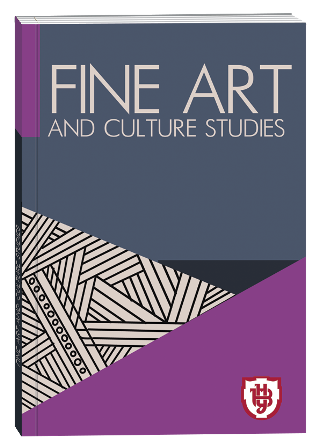REMAKE AS A LEADING PRINCIPLE OF RECEPTIVE AESTETICS
DOI:
https://doi.org/10.32782/facs-2024-1-33Keywords:
remake, reception, parody, pastiche, unfinished novel, film adaptation, novelization, mashup, fanfiction.Abstract
The aim of the article is the detection and research of methods of genre transformation and artistic techniques of transformation of pretexts from Antiquity to the present. Mythological thinking laid the foundations of generalized plots, which become a limitless source of inspiration for the transformation of mythical images and plots in the actual conditions of a certain era. The concept of the main myth or monomyth implies the presence of mythologems characteristic of Indo-European mythology, which are manifested in variable differences in the myths of different ethnic groups. Transformational processes in mythological plots have acquired the concept of "reoccupation" of the myth. Subsequently, methods of retelling samples of "high" art in low language, parody, pastiche or mash-up emerged in literature, which together made up genres that also involve the process of transforming involved plots, images and symbols of the past. There are examples of borrowing, reworking and "adding" to literary works in the Middle Ages, which gradually formed into an independent genre of the novel-sequel from the end of the 17th century. Then the number of such works grew due to the extreme popularity of certain plots. The "unfinished novel" genre also appears, in which the work is interrupted by the author at the climax of the story and becomes a popular object for additions among readers who are fans of the given plot. Evolution of the cinema accelerates the process of exchanging plots between literature and films: film adaptation and novelization of films. At the turn of the 21st century, appropriation becomes a kind of philological game, a puzzle that an experienced reader can recognize in the text by discovering borrowings from different works and different eras. Such a strategy assumes high competence and erudition of the reader. The latest practices in modern literature head towards an attempt to revive the characters and stories of the past, to give them a continuation, reinterpreting them in an authentic epic or transferring them to the present, which is embodied in the genres of network literature mashup and fan fiction. Methodology. The article uses historical method of researching varieties of text remaking, comparative analysis of the methods of transformation of literary works and the interaction of authors with texts of different eras. Also it summarizes the method of transformation of the texts. The scientific novelty. The article puts forward a generalizing way of interaction of authors with texts, which exists in the European tradition as «réécriture» or «remake». Remake as a way of reworking, transforming and modernizing texts, plots and images of the past appears as a generalized method of their preservation, transfer to the present, an attempt to convey modern audiences eternal stories in current language. Conclusions. Remake as a creative method of transformation stands at the basis of many literary genres and can be an effective way of returning and renewing symbols, images and plots of the past.
References
Kristeva J. Desire in Language: A Semiotic Approach to Literature and Art. New York : Columbia University Press, 1980. 305 p.
Benjamin V. The Storyteller. The Novel: An Anthology of Criticism and Theory 1900-2000 / ed. By Hale E.D. Malden, Massachusetts, 2006. P. 361–378.
Foucault M. Language, Counter-Memory, Practice. UK : Cornwall University Press. 1977. 240 p.
Jameson F. Postmodernism: The Culture of Late Capitalism. New Left Review. 1984. № 146. Р. 53–92.
Hutcheon L. A Poetics of Postmodernism: History, Theory and Fiction. London, 1988. 268 p.
Overing J. The Role of Myth: An Anthropological Perspective, or: «The Reality of the Really Made Up». Myths and Nationalhood / ed. by Hosking G., Schopflin G. New York, 1997. P. 1–18.
Borges J.L. The Gold of the Tigers: Selected Later Poems. New York : Dutton, 1977. 95 p.
Campbell J. The Hero with a Thousand Faces. CA, 2008. 432 p.
Blumenberg H. Arbeit am Mythos. Berlin : Suhrkamp, 2001. 699 p.
Genette G. Palimpsests: Literature in the Second Degree. CA: University of Nebraska Press, 1997. 490 p.
Гусерль Е. Ідеї чистої феноменології і феноменологічної філософії. Харків : Фоліо, 2021. 348 c.
Ingarden R. The Literary Work of Art. Evanston, IL : Northwestern University Press, 1973. 415 p.
Iser W. The Act of Reading: A Theory of Aesthetic Response. Baltimore, MD : Johns Hopkins University Press, 1980. 224 p.
Jauss H.R., Benzinger E. Literary History as a Challenge to Literary Theory. New Literary History. 1970. Vol. 2. № 1. P. 7–37. https://doi.org/10.2307/468585
Polti G. The 36 Dramatic Situations. Franklin, OH, 1921. 206 p.
Cawelti J.G. Adventure, Mystery and Romance: Formula Stories as Art and Popular Culture. Chicago, IL : University of Chicago Press, 1977. 344 p.
Cook M., Plagnol-Dieval M.-E. Reecritures 1700–1820 (French Studies of the Eighteenth and Nineteenth Centuries). Berlin, 2002. 298 p.
Hutcheon L. A Theory of Parody: The Teaching of Twentieth Century Art Forms. Champaign, IL : University of Illinois Press, 2000. 168 p.
Rebei M. A Different Kind of Circularity: From Writing and Reading to Rereading and Rewriting. LISA Revue. 2004. Vol. II(5). P. 45–59. https://doi.org/10.4000/lisa.2895
Domino M. La réécriture de texte littéraire Mythe et Réécriture. Semen, revue de Semio-linguistiq revue des textes et discours. 1987. № 3. https://doi.org/10.4000/semen.5383
Genette G., Maclean M. Introduction to the Paratext. New Literary History. 1991. Vol. 22(2). P. 261–272.
Letisser G. The Dickensian Tropism in Contemporary Fiction. Cahiers, Victoriens et Edouardiens. 2012. Horsserie. P. 245–259. https://doi.org/10.4000/cve.12419
Genette G. Figures III. Paris : Editions du Seuil. 1972. 341 p.
Hellekson K., Busse K. The Fan Fiction Studies Reader. University of Iowa Press, 2014. 254 p. https://doi.org/10.2307/j.ctt20p58d6
Leawenworth M.L. The Paratext of Fan Fiction. Narrative. 2015. Vol. 23(1). P. 40–60.
Barthes R. The Death of the Author. Image, Music, Text. London : Fontana, 1977. P. 142–148.







